 |
| |
MI6 trawls the archives to see how critics of
the day received Roger Moore's third outing as James
Bond in the 1977 film "The Spy Who Loved Me"...
|
|
Time Tunnel: Review Rewind
7th March 2009
New York Times - July 28th,
1977
During the course of "The
Spy Who Loved Me," James
Bond vanquishes an amphibious building that looks like a giant
spider, a 7 foot 2 inch villain with metal fangs, hundreds
of hapless extras and one very beautiful broad, but he hardly
ever comes to grips with his most insidious adversary, the
James Bond formula.
The same conventions that
have provided 10 Bond movies with their patent pizazz also
serve as a straitjacket, and these days a Bond film is
interesting only insofar as it quietly subverts the series'
old tricks. Happily, "The Spy Who Loved Me" has
its share of self-mockery—not enough for a full-scale
send-up, but enough to give shopworn old 007 a shot in
the arm.
The motivating sentiment behind the Bond movies has always
been envy: the viewer, poor slob, is expected to covet
Bond's women, admire his elaborate playthings and marvel
at his ability to chase through the desert in evening clothes
without getting dusty. Fifteen years ago, at the time of "Dr.
No," this sort of thing was a great deal more effective
than it is today, because the notion was new and the gadgets
could be genuinely dazzling. But by now Bond fans have
seen so many fast cars and floozies come and go that they
may be almost as jaded as James himself.
Almost, but not quite: Roger
Moore is so enjoyably unflappable
that you sometimes have to look closely to make sure he's
still breathing. |
|
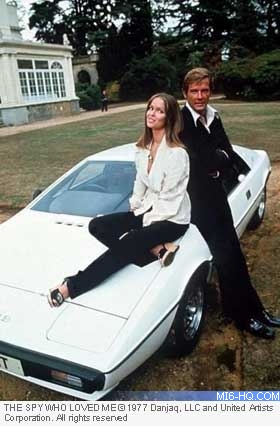 |
Presented with a fabulous new
white Lotus, he drives off impatiently without even examining
the car's
special accessories (as it turns out, the Lotus can swim).
Seduced by a conniving cutie, he looks desperately bored.
Mr. Moore has the anonymous aplomb of a male
model—appropriate, because the film is littered with trademark-bearing
merchandise — and he seems incapable of bringing much individualized
zest to the role. But his exaggerated composure amounts to a
kind of backhanded liveliness. Though Mr. Moore doesn't compromise
the character, he makes it amusingly clear that hedonism isn't
all it's cracked up to be.
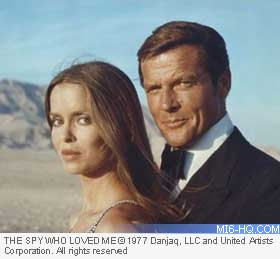
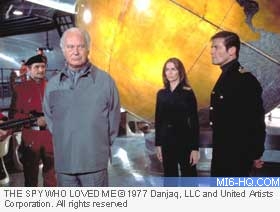
|
|
The plot this time, which
bears no resemblance to that of Ian Fleming's novel, features
Curt Jurgens as
a shipping magnate determined to destroy the world and Barbara
Bach as a Russian agent who grudgingly
joins forces with Bond to pole-ax this scheme. Miss Bach
is spectacular but a little dim, even by Bond standards;
certainly she makes no sense as a master spy who is almost
(but not quite) as ingenious as 007 himself.
In all fairness, Miss Bach's is an impossible role: Beauty
and brains needn't be incompatible, but maintaining the
requisite level of pulchritude of a Bond heroine is such
a full-time job that it precludes any other work more strenuous
than, say, watching Bond sip his very dry martini (shaken,
not stirred).
The film moves along at a serviceable clip, but it seems
half an hour too long, thanks to the obligatory shoot-'em-up
conclusion, filmed on the largest sound-stage in the world,
but nevertheless the dullest sequence here.
Bond's final
blowout, however lavishly produced, has long since gotten
to be old hat, and besides, it's the attention to smaller
details that has helped the series maintain its high
gloss. |
The theme song, sung by Carly Simon, ranks with Paul McCartney's
theme from "Live and Let Die" as one of the most delightful
surprises the series has had to offer—even if it is accompanied
by footage of a naked woman, in silhouette, doing silly calisthenics
on the barrel of an enormous gun.
"The Spy Who Loved Me" has a PG ("Parental Guidance
Suggested") rating even though Bond indulges in his favorite
means of exercise a little more listlessly than usual. A number
of extras are gunned down almost bloodlessly, and arch-villain
Curt Jurgens feeds his secretary to a shark.
Variety
- July, 1977
As always, story and plastic character are in the service of comic strip parody,
an excuse to star the prop department, set designer, stunt arrangers, the optical
illusion chaps, and such commercial suppliers as the maker of the sporty Lotus
car, a lethal job that also converts to an underwater craft.
When British and Russian
nuclear subs start to mysteriously vanish, two agents
are assigned by their collaborating governments to jointly
crack the case.
Curt Jurgens' arsenal includes the film's gimmick character,
a monster human known as 'Jaws', played with robotic finesse
by Richard Kiel.
The big action sequences were shot on a specially-built
stage with tank at Pinewood Studios outside London. |
|
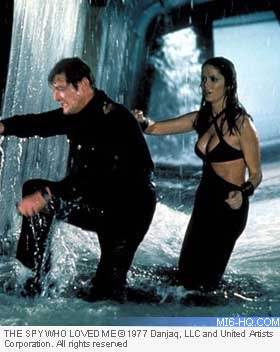
|
Time - August
8th, 1977
Jottings found on the screening-room floor after a critics' viewing
of the new James Bond film: They'll never top first stunt: skier
hurtles off precipice. Long breathtaking plunge. Shucks off skis
in midair, free-falls
for a while, then opens parachute and floats earthward. Wow.
Does anybody know this flick has nothing to
do with 1962
novel of same name, since Ian Fleming nixed sale
of anything but title to movies? Does anybody care? All that's
left of Bond formula here is 007 character, sexy starlets and
gee-whiz gadgets. (Question: What else did it ever consist of?)
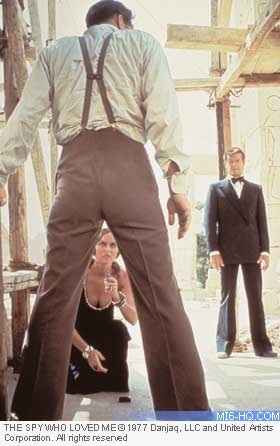
|
|
Plot seems snipped from
previous installments. Bond tangles with female Russian
spy: From Russia with Love.
They team up against seagoing megalomaniac who captures
nuclear subs belonging to both East and West and plans
to destroy world: shades of Diamonds
Are Forever. Lots
of underwater stuff: Thunderball.
Also skiing: On Her Majesty
's Secret Service. (Think
about: Curt Jurgens,
as megalomaniac, pronounces 007's name Bund. This hint
he's crypto-Nazi? Farfetched, but can anything be too
farfetched in a film like this?)
Amphibian Bondmobile. Series getting awfully ingrown.
Sexual innuendo coarser. In London HQ, Bond reported
to be on assignment in Austria, meaning he's doing you-know-what
in front of fireplace in Alpine hideaway. Thunders M: "Tell
him to pull out—immediately!" Only moment
of real wit: amphibian Bondmobile drives into sea and
becomes two-seater submarine; it veers to elude underwater
pursuers, but only after flashing turn signal—for
the wrong direction.
New Bond girl, Barbara Bach. Very pretty, especially
as seen in cushioned escape bubble. But dewy as a debutante
("Oh! James!"). Hard to believe her as dangerous
spy. |
Where are
the Honor Blackmans and Diana Riggs of yesteryear? Roger Moore,
as Bond, a road-company Sean Connery. At least he's improvement
on that instant-trivia question, George
Lazenby.
Good gadgets: wristwatch radio with tape printout of messages
received. Hollow cigarette that blows knockout gas. Flying tea
tray that decapitates human target.
Best gadget of all is human one —seven-foot thug with
preternatural strength and steel teeth, which he uses to snap
victims' spinal cords. Name: Jaws. Orthodontist's nightmare.
Running gag is that each time he is dispatched—trapped
in building cave-in, flung from speeding train, tossed into shark
tank, even torpedoed—Jaws (Richard Kiel) implacably reappears.
In his silly, mechanical, likable way, a perfect symbol for Bond
films. They're attacked, dismissed, put out of mind, but keep
coming back and back and back.
(Nope. Never did top that first Stunt.)
Related Articles
 James Bond Time Tunnel
James Bond Time Tunnel
 The
Spy Who Loved Me - Movie Coverage
The
Spy Who Loved Me - Movie Coverage